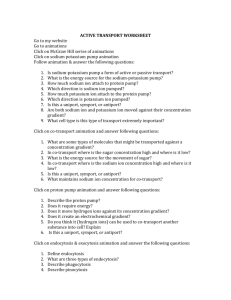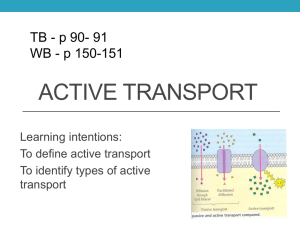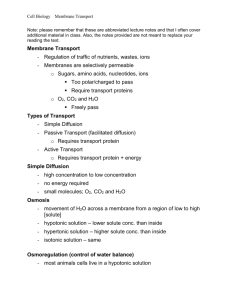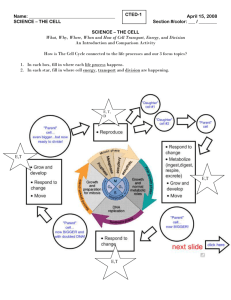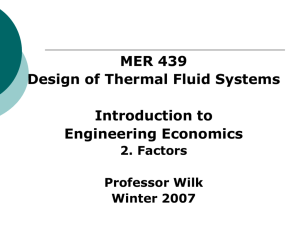Secondary Active Transport
advertisement
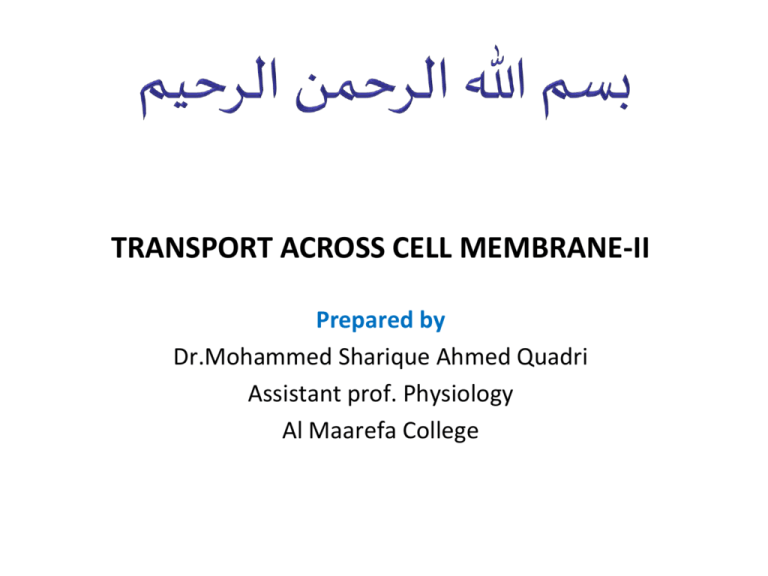
TRANSPORT ACROSS CELL MEMBRANE-II Prepared by Dr.Mohammed Sharique Ahmed Quadri Assistant prof. Physiology Al Maarefa College Objectives • Describe how energy from ATP hydrolysis is used to transport ions against their electrochemical concentration differences • Explain how energy from the Na+ and K+ electrochemical gradients across the plasma membrane can be used to drive the net “uphill” (against a gradient) movement of other solutes. • Describe the characteristics of carrier-mediated transport, and distinguish between simple diffusion, facilitated diffusion, and active transport • Describe the process of vesicular transport Active Transport Active transport • Moves a substance against its concentration gradient • Requires a carrier molecule • Requires energy Types of Active Transport • Active Transport 1. Protein Pumps • • Primary active transport – Requires direct use of ATP Secondary active transport – Driven by an ion concentration gradient established by a primary active transport system 2. Vesicular transport • • Endocytosis Exocytosis Primary Active Transport • Movement against concentration gradient • Hydrolysis of ATP directly required for the function of the carriers. • Molecule or ion binds to “recognition site” on one side of carrier protein. • Carrier protein undergoes conformational change. – Hinge-like motion releases transported molecules to opposite side of membrane. Primary Active Transport Active Transport Na+/K+ Pump • Carrier protein has enzymes activity ( ATPase) • Extrudes 3 Na+ and transports 2 K+ inward against concentration gradient. Na+/K+ Pump • Steep gradient created by this pump serves following functions: • Provides energy for “coupled transport” of other molecules. • Involvement in electrochemical impulses. • Promotes osmotic flow. Importance of Na+- K+ pump in intestinal epithelium • High osmotic pressure created by movement of sodium causes water to move from intestinal lumen to interstitial space • Protein and glucose r transported actively by cotransport with sodium • Chloride passively follow the electrical gradient created by sodium Secondary Active Transport • Transport of two or more solutes are Coupled . • Energy needed for “uphill” movement obtained from “downhill” transport of Na+. • Hydrolysis of ATP by Na+/K+ pump required indirectly to maintain [Na+] gradient. Secondary Active Transport • Cotransport (symport): – Molecule or ion moving in the same direction as Na+. • Countertransport (antiport): – Molecule or ion moving in the opposite direction of Na+. cotransport Counter transport – Molecule or ion moving in the opposite direction – E.g. Na+-Ca2+ exchange – As with cotransport it also uses Na gradient established by the Na+K+ ATPase as an energy source – Na+ moves downhill & Ca2+ moves uphill Vesicular transport across membrane • Exocytose • Endocytosis Types of Active Transport Types of Active Transport Vesicle-mediated transport Vesicles and vacuoles that fuse with the cell membrane may be utilized to release or transport chemicals out of the cell or to allow them to enter a cell. Exocytosis is the term applied when transport is out of the cell. 18 19 References • Human physiology by Lauralee Sherwood, fifth edition • Text book physiology by Guyton &Hall,11th edition • Text book of physiology by Linda .s contanzo,third edition 20
